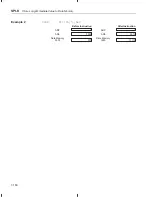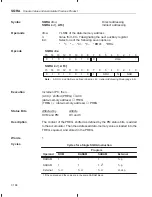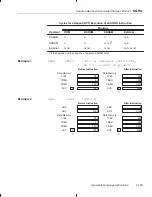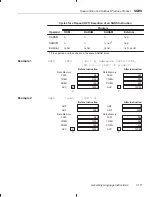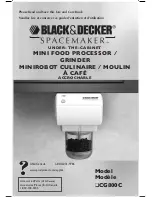
SUBC
Conditional Subtract
7-180
Syntax
SUBC
dma
Direct addressing
SUBC
ind [, ARn]
Indirect addressing
Operands
dma:
7 LSBs of the data-memory address
n:
Value from 0 to 7 designating the next auxiliary register
ind:
Select one of the following seven options:
* *+ *– *0+ *0– *BR0+ *BR0–
SUBC
dma
15
14
13
12
11
10
9
8
7
6
5
4
3
2
1
0
0
0
0
0
1
0
1
0
0
dma
SUBC
ind [, ARn]
15
14
13
12
11
10
9
8
7
6
5
4
3
2
1
0
0
0
0
0
1
0
1
0
1
ARU
N
NAR
Note:
ARU, N, and NAR are defined in Section 6.3,
Indirect Addressing Mode (page 6-9).
Execution
For (ACC)
≥
0 and (data-memory address)
≥
0:
Increment PC, then ...
(ACC) – [(data-memory address)
×
2
15
]
→
ALU output
If ALU output
≥
0
Then (ALU output)
×
2 + 1
→
ACC
Else (ACC)
×
2
→
ACC
Status Bits
Affects
OV and C
Description
The SUBC instruction performs conditional subtraction, which can be used for
division as follows: Place a positive 16-bit dividend in the low accumulator and
clear the high accumulator. Place a 16-bit positive divisor in data memory.
Execute SUBC 16 times. After completion of the last SUBC, the quotient of the
division is in the lower-order 16 bits of the accumulator, and the remainder is
in the higher-order 16 bits of the accumulator. For negative accumulator and/or
data-memory values, SUBC cannot be used for division.
If the 16-bit dividend contains fewer than 16 significant bits, the dividend may
be placed in the accumulator and left shifted by the number of leading nonsig-
nificant 0s. The number of executions of SUBC is reduced from 16 by that num-
ber. One leading 0 is always significant.
SUBC operations performed as stated above are not affected by the sign-ex-
tension mode bit (SXM).
Opcode

